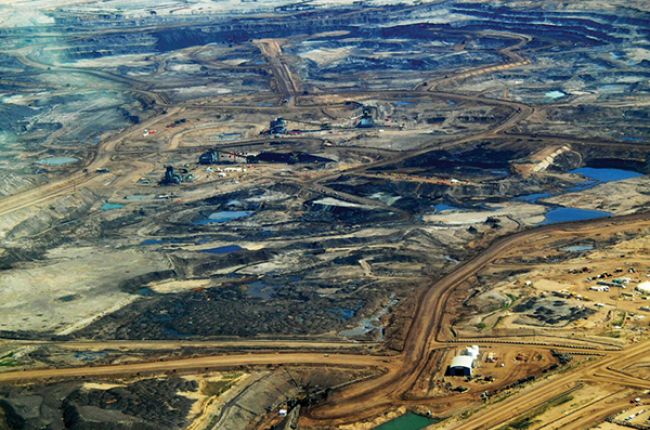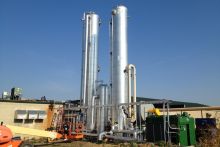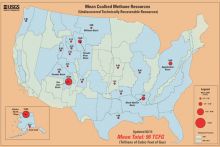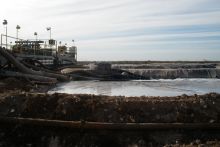
Tar sands (also called oil sands) are a mixture of sand, clay, water, and bitumen.[1] Bitumen is a thick, sticky, black oil that can form naturally in a variety of ways, usually when lighter oil is degraded by bacteria.[2] Bitumen has long been used in waterproofing materials for buildings, and is most familiar today as the binding agent in road asphalt. However, most of the bitumen produced from tar sands is refined and mixed with lighter oils to produce synthetic crude oil that can be further refined and used in much the same way as typical crude oil.[3]
Because bitumen is very thick and does not flow easily, it clings to the sand and clay and can’t be simply pumped out of the ground through wells like conventional oil. Instead, tar sands are mined in two main ways:[1,2]
- Open-pit mining – if tar sands are found near the surface, as in Alberta, Canada, they can be mined directly – much like open-pit coal mining – and then transferred to an extraction plant where the bitumen can be separated from the sand, clay, and water.
- In-situ mining – if tar sands are too deep to dig up, the bitumen can be extracted by injecting hot steam or solvents to loosen up the bitumen and allow it to flow through a well to the surface.
The largest deposits of tar sands in the world are found in Alberta (Canada) and Venezuela. The largest deposits in the United States are found in eastern Utah.[1,4]
Tar sands represent a potentially vast reserve of oil[2] but come with their own environmental challenges. Oil production from tar sands uses large amounts of land (for open-pit mining), water, and energy, when compared to other oil resources. Open-pit mining also produces a lot of waste (leftover sand, clays, and contaminants contained within the tar sands) that may pose a risk to nearby water supplies. Some of the existing and planned attempts to mitigate the environmental impacts of mining tar sands include using non-potable and recycled water, moving to in-situ rather than open-pit mining to decrease land use and waste, and using carbon capture and storage to reduce greenhouse gas emissions from the extraction and use of oil from tar sands.[5]
References
1 About Tar Sands U.S. Bureau of Land Management
2 Heavy Oil and Natural Bitumen Resources in Geological Basins of the World U.S. Geological Survey
3 Oil Sands Pennsylvania State University Fuel Chemistry Division
4 Oil Sands/Tar Sands Utah Geological Survey
5 Oil Sands: A strategic resource for Canada, North America and the global market Natural Resources Canada
Learn More
- Oil Shale/Tar Sands Guide (Website) U.S. Bureau of Land Management
Website with lots of introductory information on tar sands, including photos, maps, and links to more resources.
- Oil Shale and Tar Sands Programmatic Environmental Impact Statement (Website) U.S. Bureau of Land Management
A wide range of documents relevant to the exploration for and development of tar sands on public lands, associated with the 2012 Programmatic Environmental Impact Statement from the Bureau of Land Management.
- Oil Sands (Website) Government of Alberta
Hub for information on tar sands in Alberta, Canada. Includes basic publications, maps, videos, and information on legislation, royalties, and rights.
- Mining Canada's Oil Sands (Visualization) NASA
Satellite-based visualization of the land-use impacts of development in the Athabasca oil sands (Alberta, Canada) from 1984 to 2011.
- Heavy Oil and Natural Bitumen Resources in the Geological Basins of the World (Report) U.S. Geological Survey
2007 report on the global distribution and abundance of heavy oil and natural bitumen (the oil found in tar sands).
- Oil Sands (Website) Pennsylvania State University Fuel Chemistry Division
Information on how tar sands are formed, mined, and processed.
- Oil Sands/Tar Sands (Website) Utah Geological Survey
Information on Utah's tar sand resources, the largest in the United States.






